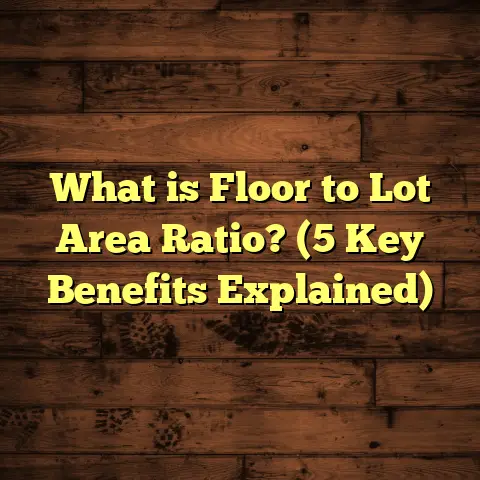What is CTN Abbreviation in Flooring? (5 Key Insights Revealed)
I’ve often found myself in conversations with homeowners and contractors who get stuck on terminology when planning flooring projects. One abbreviation that frequently pops up and causes confusion is CTN. You might have seen it in quotes, invoices, or material lists and wondered, “What exactly does CTN mean in flooring?” I’ve been through this myself many times, and understanding CTN can make your project smoother, from budgeting to installation.
What is CTN in Flooring?
CTN stands for Carton. In flooring, especially when dealing with materials like laminate, engineered hardwood, vinyl planks, or tiles, CTN refers to the packaging unit — basically, the box or carton that contains a specific quantity of flooring material. This abbreviation is super common in product specifications and supplier communications.
For example, if you order laminate flooring, the price might be listed per CTN rather than per square foot. Each carton usually holds multiple planks or tiles designed to cover a certain square footage. So when you see “10 CTN,” it means ten boxes of the flooring product.
Understanding what a CTN contains exactly can help you estimate how much material you need and avoid ordering too little or too much.
Why Does CTN Matter?
Let me share a quick story: I once had a client who ordered flooring based on square footage alone without clarifying how many square feet each CTN covered. When the shipment arrived, they had fewer cartons than needed because the packaging size was smaller than expected. This delayed the project and increased costs due to rush orders.
Knowing the exact coverage per CTN helps prevent such mishaps. It also allows accurate calculation of waste or extra material needed for cuts and mistakes.
1. Coverage Per Carton Varies by Material and Brand
One thing I’ve learned over the years is that not all cartons are created equal. The coverage per CTN can vary widely depending on the type of flooring and even the brand you choose.
Laminate Flooring
Laminate flooring cartons typically hold between 18 to 25 square feet of flooring material. Some budget brands pack fewer planks per carton to keep shipping costs down, while premium brands might offer slightly larger coverage cartons. This variability can make it tricky when comparing prices based solely on carton cost.
For instance, I worked on a project where two brands had the same price per carton — $40 each — but one carton covered 20 sq ft while the other covered 25 sq ft. That 25% difference meant a significant price gap when calculated per square foot.
Engineered Hardwood
Engineered hardwood usually comes in cartons covering a smaller area — around 15 to 20 square feet per carton. The planks tend to be thicker and heavier than laminate or vinyl, so fewer pieces fit into a single box.
I remember installing engineered hardwood in a client’s living room where each carton weighed nearly 50 pounds due to its density and thickness. Handling multiple cartons required careful planning for labor and storage space.
Vinyl Plank Flooring
Vinyl plank cartons generally offer more coverage — about 20 to 30 square feet per carton — since vinyl is lighter and thinner. This makes vinyl easier to transport and handle on-site.
One time I used vinyl plank flooring for a basement renovation project. The cartons were lightweight and easy to stack, which sped up the installation process considerably compared to hardwood.
Ceramic and Porcelain Tiles
Tiles are a different beast altogether. Tile cartons usually cover less area — often 10 to 15 square feet per carton — because tiles are heavy and fragile. Plus, tiles come in various sizes (from small mosaics to large format slabs), so carton coverage depends heavily on tile dimensions.
On a commercial job I did, we had to order dozens of cartons of large-format porcelain tiles. Each carton weighed close to 60 pounds, requiring forklift assistance for unloading.
2. Waste Factor Should Be Added When Calculating CTNs
This point cannot be stressed enough. Flooring projects almost always require ordering extra material beyond your exact floor measurements to account for cuts, mistakes, and future repairs.
Why Waste Happens
When cutting planks or tiles around corners, doorways, or irregular areas, you naturally generate scraps that cannot be reused. Also, some pieces may get damaged during transportation or installation.
I recall working on a kitchen floor with complex angles where we used about 8% extra material compared to the floor area just to cover all the cuts.
How Much Waste Is Enough?
The general rule of thumb is to add 5-10% extra material for waste:
- 5% waste for simple rectangular rooms with straight cuts.
- 7-10% waste for rooms with irregular shapes or complex layouts.
- 10%+ waste if you plan on keeping spare material for future repairs or if the flooring pattern requires precise matching.
For example, if your floor area is 500 square feet and your waste factor is 7%, you should order about: 500×1.07=535 square feet500 \times 1.07 = 535 \text{ square feet}
This translates into more cartons depending on coverage per CTN.
Personal Experience with Waste
Once on a large home addition project, we underestimated waste by ordering only 3% extra. Midway through installation, we ran short by two cartons because of several cut errors and damaged planks. This mistake cost us an emergency order with expedited shipping fees.
Since then, I always recommend clients add at least 7% waste unless their project is extremely straightforward.
3. Pricing is Often Per CTN Instead of Per Square Foot
If you’re new to flooring purchasing, one confusing aspect is how pricing is listed by suppliers.
Why Per Carton Pricing Exists
Manufacturers and distributors typically price flooring by carton because it simplifies shipping logistics and inventory management. It’s easier for warehouses to handle boxes than individual planks or tiles.
How to Calculate Price Per Square Foot from CTN Price
If you want to compare products or understand your budget better, calculate price per square foot using: Price per sq ft=Price per CTNSquare footage per CTN\text{Price per sq ft} = \frac{\text{Price per CTN}}{\text{Square footage per CTN}}
For example:
- Price per CTN = $50
- Coverage per CTN = 20 sq ft
Price per sq ft=5020=2.50\text{Price per sq ft} = \frac{50}{20} = 2.50
This helps compare products priced differently or with different carton coverage.
Real-World Example
I once compared two laminate brands for a client:
| Brand | Price per CTN | Sq Ft per CTN | Price per Sq Ft |
|---|---|---|---|
| A | $45 | 20 | $2.25 |
| B | $52 | 25 | $2.08 |
Despite Brand B’s higher carton price, it was actually more cost-effective per square foot because of larger coverage per carton.
This kind of math saves money and confusion during ordering.
4. Different Flooring Types Affect CTN Size
Understanding how different materials impact carton sizes can help you plan storage and transportation logistics better.
Weight Differences
Hardwood cartons are heavier due to solid wood density (can be up to 50 lbs per carton), while vinyl cartons are lighter (around 25 lbs).
When working on multi-material projects, I always plan labor accordingly since unloading heavy hardwood cartons needs more manpower or equipment.
Thickness Variation
Thicker materials take up more space in each carton but don’t necessarily cover more square footage. For example:
- A 12mm laminate plank may pack fewer boards per box than an 8mm plank.
- Engineered hardwood thickness ranges from 3/8 inch to over ¾ inch affecting carton weight/size.
Carton Dimensions Affect Storage
Larger cartons require more storage space onsite before installation starts.
On one job with oversized engineered hardwood planks (7 inches wide by 48 inches long), cartons were bulky and hard to stack efficiently in a small room. Planning storage space ahead avoided damage from cramped stacking.
5. Storage and Handling Depend on CTN Size
How you manage cartons onsite can impact your project timeline and costs.
Protecting Cartons From Damage
Since CTNs are your packaging units, keeping them dry and safe from physical damage matters a lot.
I always recommend storing cartons off the ground on pallets and covering them with plastic sheeting if exposed to weather. Moisture can cause warping or mold growth inside cartons — ruining your investment before installation begins.
Transport Considerations
Heavy or bulky cartons need careful handling during delivery and moving around your site.
For example:
- Hardwood requires forklift or dolly transport.
- Vinyl or laminate can be carried manually by one or two people.
Planning transport logistics based on carton size saves time and prevents accidents.
How I Use FloorTally to Manage CTN Calculations
When managing projects — whether my own or clients’ — I rely on tools like FloorTally to take the guesswork out of ordering materials by CTN. FloorTally lets me input room dimensions, select flooring type, and it automatically calculates how many cartons I’ll need including waste factors.
This tool saves me time juggling different carton sizes and prices from multiple suppliers. Plus, it helps me visualize total costs upfront so no surprises pop up mid-project.
For example, on a recent kitchen remodel, FloorTally showed me I needed 12 cartons of vinyl plank flooring instead of the 10 I initially thought based on rough area estimates. That extra planning helped avoid a last-minute scramble for materials.
More About FloorTally’s Benefits
- Handles multiple rooms or areas at once
- Lets me compare different products side-by-side
- Adjusts waste factors based on floor complexity
- Incorporates local labor cost estimates for better budgeting
Using it regularly has become part of my workflow because it reduces errors that come from manual calculations — especially when orders are large or complicated.
Comparing CTN with Other Flooring Measurement Terms
You might ask: how does CTN compare with other terms like square foot (sq ft) or linear foot (ln ft)? Here’s a quick rundown:
| Term | Meaning | Usage in Flooring |
|---|---|---|
| CTN | One carton/package of flooring material | Used by suppliers for pricing/packaging |
| Square Foot (sq ft) | Area measurement | Most common for calculating floor size |
| Linear Foot (ln ft) | Length measurement | Used when ordering strips like hardwood |
CTN relates closely to square footage but represents the packaging unit rather than raw area. This distinction is important when ordering because you buy flooring by carton but install by square footage.
Additional Insights From My Flooring Projects
Having worked on dozens of projects using various flooring types over the years, here are some extra insights connected to CTNs that might help you:
Ordering Extra Cartons For Repairs Later
I always advise clients to keep at least one unopened carton after installation completes. Floors get scuffed or damaged over time — having matching planks on hand makes repairs easier without noticeable mismatches.
How Shipping Costs Tie Into CTNs
Sometimes suppliers charge shipping based on carton count or weight rather than total square footage. Ordering fewer cartons with higher coverage can reduce shipping costs even if per-carton price is slightly higher.
Bulk Discounts Based on Cartons Ordered
Many suppliers offer discounts when you purchase multiple cartons at once. Knowing exactly how many cartons you need upfront gives you bargaining power during negotiations.
Case Study: Flooring Project With CTN Calculation Challenges
A few months ago, I helped a family renovate their entire first floor using engineered hardwood flooring from a local supplier. Here’s how understanding CTNs saved the day:
- The family’s floor area was about 1200 sq ft.
- The supplier’s engineered hardwood came in cartons covering 18 sq ft each.
- Initial estimate was 70 cartons (1200 /18 = ~66 + waste factor).
- We added a 10% waste factor → ordered 77 cartons.
- After delivery, we discovered some cartons were slightly underfilled due to manufacturer variance.
- We had a buffer of extra cartons which covered this discrepancy without delaying installation.
- Without proper CTN knowledge and waste planning, this would have caused costly delays and emergency orders.
This experience reinforced my belief that paying attention to CTNs early avoids headaches later in flooring projects big or small.
Breaking Down Cost Estimation Using CTNs
Budgeting flooring projects accurately means understanding how CTNs affect total cost beyond just material price:
- Material Cost: Price per carton multiplied by number of cartons needed.
- Waste Material: Additional cartons ordered as buffer.
- Shipping Cost: Often calculated per carton or weight.
- Labor Cost: Installation usually based on square footage but knowing carton count helps schedule delivery timing.
- Accessory Costs: Transition strips, underlayment sometimes bundled separately but also affected by total area covered by cartons.
- Potential Overruns: Emergency orders due to miscalculated CTNs can increase costs dramatically.
By having precise data on CTNs from suppliers combined with tools like FloorTally, I can give clients realistic budgets that minimize surprises down the road.
How Carton Sizes Impact Environmental Waste and Sustainability Efforts
I’ve noticed growing interest among homeowners about sustainable building practices including flooring choices. Carton size plays into this in several ways:
- Larger cartons may reduce packaging material usage per square foot of flooring.
- Efficient packing lowers transportation emissions by optimizing truck space.
- Ordering correct number of cartons reduces excess materials that might end up as landfill waste if unused.
In one green remodel project I worked on last year, we chose a manufacturer whose packaging minimized cardboard use while ensuring product safety during shipping — an added bonus beyond just cost savings.
FAQ Section: Common Questions About CTNs in Flooring
Q: Can I order individual planks instead of full cartons?
A: Usually no. Most suppliers sell flooring only by full cartons due to inventory management and shipping efficiency.
Q: How do I know how many planks are in each CTN?
A: Check product datasheets or ask your supplier directly—they typically list number of pieces per carton along with coverage area.
Q: Is it better to order extra cartons upfront or reorder later if needed?
A: Ordering extra upfront avoids delays but ties up funds initially; reordering risks availability issues. Usually ordering 7-10% extra upfront is safest bet.
Q: What happens if I open a carton but don’t use all pieces?
A: Once opened, leftover planks may degrade if not stored properly; try to keep them flat in climate-controlled areas if saving for repairs.
Closing Thoughts: My Personal Take on Mastering CTNs For Flooring Success
If there’s one thing I’ve learned through years installing floors across different homes and commercial spaces — mastering the concept of CTNs saves time, money, and frustration. It’s such a simple term but packed with meaning that affects everything from ordering materials correctly to managing budgets effectively.
Next time you see “CTN” on your invoice or purchase order, you’ll know it means carton, containing a specific number of planks or tiles designed to cover part of your floor area. Treat each carton count as a critical piece of your project puzzle — plan for waste, understand coverage differences by material type, and use tools like FloorTally for smooth calculations.
Flooring involves many details behind the scenes that don’t get talked about enough—CTNs are one of those details that quietly make all the difference between a smooth installation and a chaotic one.
Feel free to reach out if you want help interpreting your flooring order details or need advice on calculating how many cartons you need for your next project!





